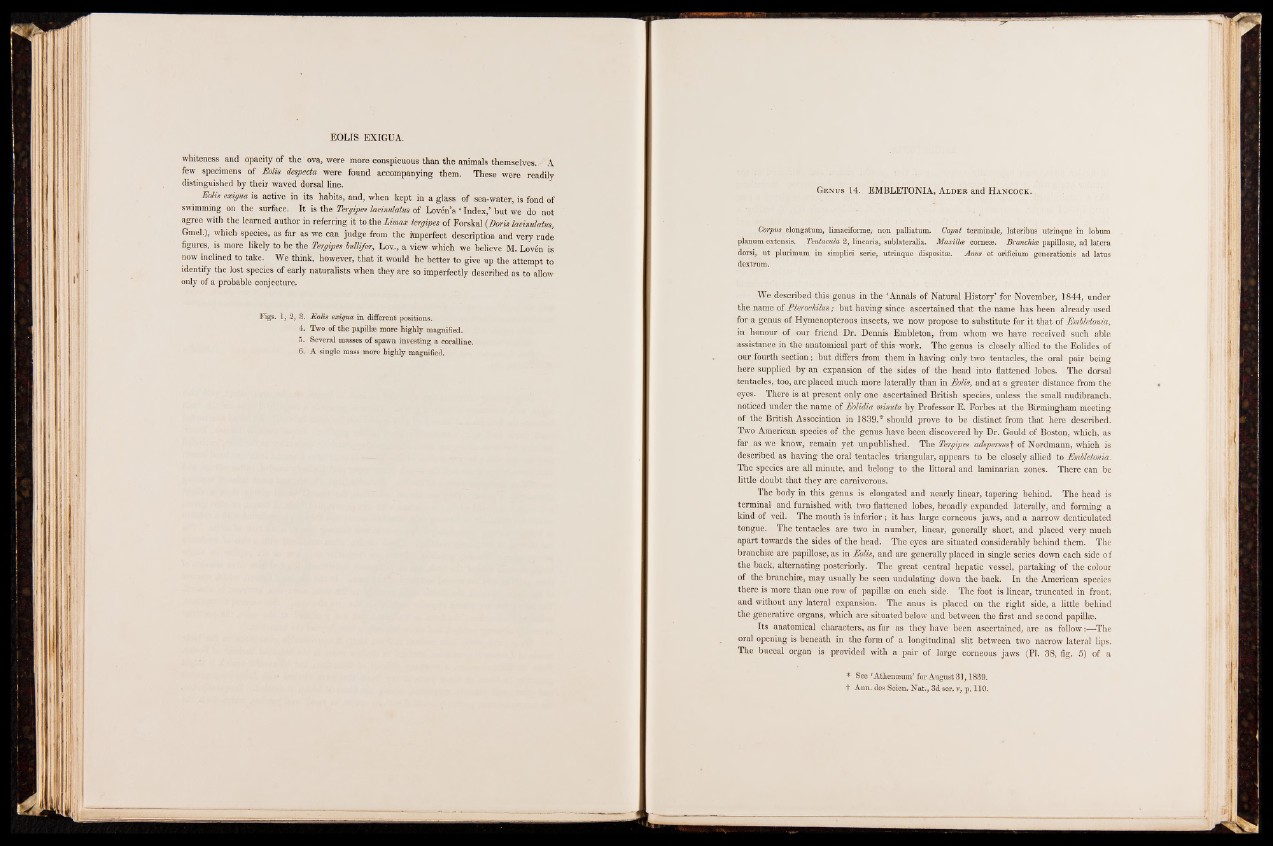
whiteness and opacity of the ova, were more conspicuous than the animals themselves.. A
few specimens of Solis despecta were found accompanying them. These were readily
distinguished by their waved dorsal line.
Solis exigua is active in its habits, and, when kept in a glass of sea-water, is fond of
swimming on the surface. It is the Tergipes lacinulatus of Loven’s ' Index,’ but we do not
agree with the learned author in referring it to the Umax tergipes of Forskal (Boris lacinulatus,
Gmel.), which species, as far as we can judge from the imperfect description and very rude
figures, is more likely to be the Tergipes Mlifer, Lov,, a view which we believe M. Loven is
now inclined to take. We think, however, that it would be better to give up the attempt to
identify the lost species of early naturalists when they are so imperfectly described as to allow
only of a probable conjecture.
Figs. 2, 3. Eolis exigua in different positions.
4. Two of the papillae more highly magnified.
5. Several masses of spawn investing a coralline.
6. A single mass more highly magnified.
Genus 14. EMBLETONIA, Alder and Hancock.
Corpus elóngatum, limaciforme, non palliatum. Caput terminale, lateribus utrinque in lobum
planum extensis. Tentacula 2, linearia, sublateralia. Maxilla corneae. Bronchia papillosae, ad latera
dorsi, ut plurimum in simplici serie, utrinque dispositae. Anus et orificium generationis ad latus
dextrum.
We described this genus in the ‘Annals of Natural History’ for November, 1844, under
the name oi,Pterochilus; but having since ascertained that the name has been already used
for a genus of Hymenopterous insects, we now propose to substitute for it that of Embletonia,
in honour of . our friend Dr. Dennis Embleton, from whom we have received such able
assistance in the anatomical part of this work. The genus is closely allied to the Eolides of
our fourth section; but differs from them in having only two tentacles, the oral pair being
here supplied by an expansion of the sides of the head into flattened lobes. The dorsal
tentacles, too, are placed much more laterally than in Eolis, and at a greater distance from the
eyes. There is at present only one ascertained British species, unless the small nudibranch,
noticed under the name of Eolidia minuta by Professor E. Forbes at the Birmingham meeting
of the British Association in 1839,* should prove to be distinct from that here described.
Two American species of the genus have been discovered by Dr. Gould of Boston, which, as
far as we know, remain yet unpublished. The Tergipes adspersusf of Nordmann, which is
described as having the oral tentacles triangular, appears to be closely allied to Embletonia.
The species are all minute, and belong to the littoral and laminarian zones. There can be
little doubt that they are carnivorous.
The body in this genus is elongated and nearly linear, tapering behind. The head is
terminal and furnished with two flattened lobes, broadly expanded laterally, and forming a
kind of veil. The mouth is inferior; it has large corneous jaws, and a narrow denticulated
tongue. The tentacles are two in number, linear, generally short, and placed very much
apart towards the sides of the head. The eyes are situated considerably behind them. The
branchiae are papillose, as in Eolis, and are generally placed in single series down each side o f
the back, alternating posteriorly. The great central hepatic vessel, partaking of the colour
of the branchiae, may usually be seen undulating down the back. In the American species
there is more than one row of papillae on each side. The foot is linear, truncated in front,
and without any lateral expansion. The anus is placed on the right side, a little behind
the generative organs, which are situated below and between the first and second papillae.
Its anatomical characters, as far as they have been ascertained, are as follow:—The
oral opening is beneath in the form of a longitudinal slit between two narrow lateral lips.
The buccal organ is provided with a pair of large corneous jaws (PI. 38, fig. 5) of a
* See ‘Athenaeum* for August 31,1839.
t Ann. des Scien. Nat., 3d ser. v, p. 110.